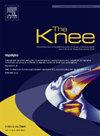保留十字韧带全膝关节置换术中保留后十字韧带不影响术后临床结果,包括遗忘关节评分12。
IF 2
4区 医学
Q3 ORTHOPEDICS
引用次数: 0
摘要
背景:在全膝关节置换术(TKA)中保留的后交叉韧带(PCL)的体内功能仍然不明确。本研究旨在探讨使用匹配假体和匹配植入物的CR-TKA中保留的PCL本身是否影响术后临床结果,包括遗忘关节评分12 (FJS-12)。方法:我们前瞻性地纳入了62例接受膝关节骨性关节炎原发性全膝关节置换术(TKA)的患者的93个膝关节,使用Triathlon全膝关节系统和一个十字架替代(CS)插入物(CS-insert)。cr组保留PCL, cs组切除PCL。比较两组最终随访(术后至少1年)的临床结果,包括FJS-12、影像学参数以及术中影响因素,如各组份角度、胫骨后斜度、后髁偏移、关节间隙、关节平衡、关节松弛度。结果:CR-组与cs -组术前患者特征及术中影响因素均无显著差异。此外,两组在术后伸展(p = 0.14)和屈曲(p = 0.41)、膝关节损伤和骨关节炎结局评分(69.4±8.4比72.9±9.5,p = 0.07)和中位FJS-12评分(75.0比64.6-84.3)比82.0 (72.4-89.6),p = 0.16)方面无显著差异。结论:在CR-TKA中,保留的PCL本身不影响术后临床结果,包括FJS-12。本文章由计算机程序翻译,如有差异,请以英文原文为准。
Preservation of posterior cruciate ligament in cruciate-retaining total knee arthroplasty with a cruciate-substituting insert does not affect postoperative clinical outcomes, including Forgotten Joint Score 12
Background
The in vivo function of the preserved posterior cruciate ligament (PCL) in cruciate-retaining (CR) total knee arthroplasty (TKA) is still ill-defined. This study aimed to investigate whether the preserved PCL itself affects postoperative clinical outcomes, including the Forgotten Joint Score 12 (FJS-12), in CR-TKA using matched prostheses and matched inserts.
Methods
We prospectively included 93 knees from 62 patients undergoing primary TKA for knee osteoarthritis using the Triathlon total knee system with a cruciate-substituting (CS) insert (CS-insert). The PCL was preserved in the CR-group, while it was sacrificed in the CS-group. Postoperative clinical outcome at the final follow-up (at least one year postoperatively), including FJS-12, radiologic parameters, and intraoperative influencing factors such as each component angle, posterior tibial slope, posterior condylar offset, joint gap, joint balance, and joint laxity were compared between the two groups.
Results
There were no significant differences between CR- and CS-groups in terms of preoperative patient characteristics, as well as intraoperative influencing factors. In addition, there were no significant differences between the two groups regarding postoperative extension (p = 0.14) and flexion (p = 0.41), Knee Injury and Osteoarthritis Outcome Score (69.4 ± 8.4 versus 72.9 ± 9.5, p = 0.07), and median FJS-12 score (75.0 (64.6–84.3) versus 82.0 (72.4–89.6), p = 0.16).
Conclusions
In CR-TKA, the preserved PCL itself does not affect postoperative clinical outcomes, including FJS-12.
求助全文
通过发布文献求助,成功后即可免费获取论文全文。
去求助
来源期刊

Knee
医学-外科
CiteScore
3.80
自引率
5.30%
发文量
171
审稿时长
6 months
期刊介绍:
The Knee is an international journal publishing studies on the clinical treatment and fundamental biomechanical characteristics of this joint. The aim of the journal is to provide a vehicle relevant to surgeons, biomedical engineers, imaging specialists, materials scientists, rehabilitation personnel and all those with an interest in the knee.
The topics covered include, but are not limited to:
• Anatomy, physiology, morphology and biochemistry;
• Biomechanical studies;
• Advances in the development of prosthetic, orthotic and augmentation devices;
• Imaging and diagnostic techniques;
• Pathology;
• Trauma;
• Surgery;
• Rehabilitation.
 求助内容:
求助内容: 应助结果提醒方式:
应助结果提醒方式:


